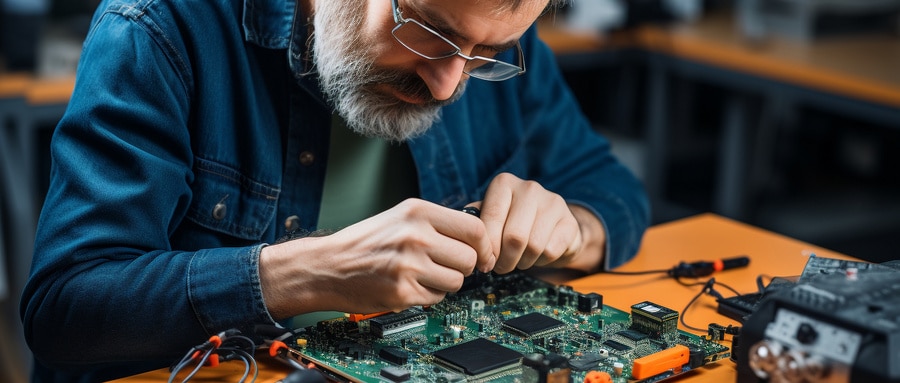Unraveling the Mystery of 6-Layer PCB Stackup: A Comprehensive Overview and Guide
As technology progresses, PCB designs have become more complex. One of the more commonly encountered multilayer PCBs is 6-layer stackup PCBs – and this article offers an in-depth explanation.
Key Components of a 6-Layer PCB Stackup
- Understanding the Basics
- Practical Applications of 6-Layer Stackups
- Decoding Layer Design for 6-Layer PCBs
- Essentials of Stackup Design and Planning
- Features and Benefits of 6-Layer PCBs
- Common Design Challenges and Solutions in 6-Layer PCB Production
- Elements Key Factors Optimizing 6-Layer PCB Performance
- Promising Future Trends in 6-Layer PCB Technology
Understanding the Basics
A 6-layer PCB stackup is a circuit board composed of six layers made up of fiberglass, copper and other materials stacked and connected via heat and adhesive bonds. By exploring its structure and function more deeply, you can gain knowledge about capacitive loading, impedance balance and other critical aspects of electronics.
Practical Applications of 6-Layer PCB Stackups
6-layer PCBs stand out as being superior performers and intricate designers, proving useful in sophisticated electronic products like laptops, smartphones and GPS technology. Read up on how 6-layer PCBs have found use across industries including telecomms, defense and medical device industries.
Decoding the Design: Components of a 6-Layer PCB
Unravel the mysteries of 6-layer PCB stackup with a thorough analysis of every layer’s role and function, from signal layers to power and ground planes. Unlock what lies within each stackup layer!
Designing and Planning Stackups
Effective stackup design has a profound effect on PCB performance. Learn about essential considerations related to signal integrity, electromagnetic compatibility, thermal properties and more for designing an optimized 6-layer PCB board.
Features and Advantages of 6-Layer PCBs
Not sure why a 6-layer PCB stackup should be your choice? Here we discuss its numerous advantages – improved signal integrity, compactness and noise reduction capabilities being just a few of them.
Common Challenges and Solutions in Six-Layer PCB Design
Designing a 6-layer PCB presents unique challenges. Explore effective strategies for dealing with crosstalk, interference and capacitive coupling as you design.
Key Factors in Optimizing 6-Layer PCB Performance
From understanding layer interactions and material selection/layout strategies, this section takes an in-depth look into factors that will ensure optimal performance of a 6-layer PCB.
Future Trends in 6-Layer PCB Technology
Be ahead of the game by staying abreast of emerging trends in 6-layer PCB technology, such as microvias, embedded high-density interconnects (HDI), and adaptive technology.

By the time your journey comes to an end, use the intricate knowledge of 6-layer PCB stackups you have acquired to confidently apply it to any of your projects, be it related to telecom, automotive technology or aerospace engineering. Electronics may seem complex at first glance but with proper knowledge anyone can navigate it like an expert.
This article seeks to bridge any knowledge gaps you might be facing when starting out in electronic engineering or diving deep into 6-layer PCB stackups. Get ready for a step up in your project, career, or hobby!
FAQ:
- Q: What is a 6-layer PCB stackup?
A: A 6-layer PCB stackup consists of six conductive copper layers stacked together with insulating material in between. Typically, the structure is two outer layers and four inner layers, usually designed to manage EMI controls and signal integrity. - Q: Why should I choose a 6-layer PCB stackup?
A: With more layers, it’s easier to route, manage signal integrity and plan power distribution. It also provides better electromagnetic compatibility performance due to the presence of multiple ground planes. - Q: How is the thickness of a 6-layer PCB determined?
A: The thickness of a 6-layer PCB is determined by the thickness of the prepreg and core used, along with the copper thickness on each layer. - Q: What is the typical construction of a 6-layer PCB stackup?
A: A standard 6-layer PCB typically consist of: Top Layer, Inner Layer 1 (Ground), Inner Layer 2 (Power), Inner Layer 3(Power), Inner Layer 4 (Ground) and Bottom Layer. - Q: Are there disadvantages to a 6-layer PCB stackup?
A: One main disadvantage can be cost, as they are more expensive than 2 or 4 layer PCBs due to the additional manufacturing complexity. - Q: What is the manufacturing process of a 6-layer PCB?
A: The process begins with designing the layout, etching the copper layers, stacking the layers with prepreg and core, pressing the stack-up, drilling, through-hole plating, solder mask application, and surface finishing. - Q: Can I fit all components on a 6-layer PCB?
A: This depends on the complexity of the circuit. In most scenarios, a 6-layer PCB should provide sufficient space for components and routing, but in highly complex designs, more layers may be needed. - Q: How does a 6-layer PCB improve EMI (Electromagnetic Interference)?
A: The extra ground and power planes in a 6-layer PCB can help shield signal layers and control EMI. - Q: How long does it take to manufacture a 6-layer PCB?
A: Manufacturing times vary depending on the complexity, but generally, it might take approximately 5-7 days. - Q: Where to order a 6-layer PCB?
A: Various manufacturers can produce 6-layer PCBs. It’s advisable to consider factors like cost, quality assurance, turnaround time, and customer reviews when choosing a manufacturer.























